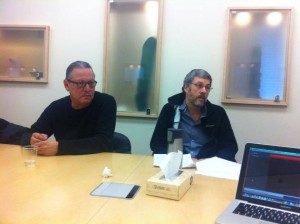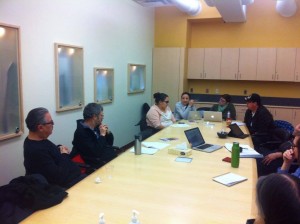Indians Wear Red: The Causes and Solutions of Aboriginal Street Gangs
The following is the second in a series of graduate student writings to emerge from the partnership between MEDIA INDIGENA and the #UMNATV Colloquium series. Here, University of Manitoba Native Studies Masters student Joe Dipple shares his thoughts following a joint presentation by Larry Morrissette and Lawrence Deane last month.

Larry Morrissette and Lawrence Deane spoke at the #UMNATV Colloquium series in February 2014. Their lecture — entitled Indians Wear Red: Colonialism, Resistance, and Aboriginal Street Gangs (based on the book of the same name) — addressed the causes of Aboriginal gang prevalence. Featuring the issue of Aboriginal gangs from the position of Aboriginal gang members, they suggested a few approaches to addressing this issue.
According to Deane and Morrissette, the men they worked with have much to teach about society, systemic racism, and colonization. Listening to these men is something not only the authors had to learn to do, but the organizations they worked with (and often tried to influence their research). Their work provides a model of empathic research and community involvement that is far more beneficial for all parties involved, as compared to an approach that goes for quick results with little community input.
Letting interviewees direct the research allows for community decision-making and the support of local, self-determination efforts (such as in education). This approach directly addresses the issues that culminate in Aboriginal youth gangs, which emerge most often from the vacuum created by systemic violence and disenfranchisement. As Deane states, gangs emerge within the power structures of close-knit communities: “The gang was the people they grew up with, it was their cousins.”
Throughout their research, Deane and Morrissette heard many stories of gang members being alone and living on the streets by the age of 12. Gangs were the place they could go to receive clothing, food, and shelter. This community was their way of overcoming the difficulties around them by becoming tougher than anything that could be thrown at them. These are deeply tied to the poverty created via the many layers of colonialism, as many of these men, as Aboriginal children, had very few opportunities in their lives. In turn, due to the institutionalization of oppression, these men were also often unable to give their children better then what they had inherited, so the cycle continues.
Finally, Morrissette and Deane stated the purpose of colonization is to keep colonized people numb, through the availability of things like drugs and alcohol, so they do not realize the pain that is being inflicted upon them. Deane directly tied these two together, stating: “Do we have a gang problem or do we have an addictions problem?” Morrissette then added: “Notice that there’s less and less bars in the north end and more pharmaceutical companies.”
In concluding, Morrissette and Deane argued that the effects of colonization have a deeply negative impact on Indigenous peoples in Canada and these can be addressed through self-determination and community-directed support. Communities, once given the opportunity to direct the support they are given, most often use resources available in effective ways. Self-determination empowers the disenfranchised to overcome many of the problems they face.

Although there are many difficulties associated with gangs, they are not the cause of the “problem.” That means the “problem” cannot be solved through hardline policies and legal attacks on gangs. Through community-directed support, self-determination, and a marked decrease in colonization (attitudes, policies, and media attention to name a few realms of colonization), the causes of gang prevalence can be diminished. Supporting the community and the people within it, whether members of gangs or not, can only help the future generations of Indigenous people, especially children, in the inner-city.


The question, “do we have a drug problem or an addiction problem”, steered my thoughts to our people “lined up down on Main Street” at clinics. With the “green rush” going on in the United States (decriminalizing of Marijauna), I would rather see them getting medical marijauna instead of pills. Two losers will be big Phama and the marijauna black market – both major contributors in the “Indian industry”. According to Stephanie Kelley’s article, “Will hemp & medical marijuana come to tobique first nation?” The New Brunswick community is stepping boldly into the future to help their community, and the world, by exploring ways to begin medical marijuana and hemp production … that locally will be a boon to our economy, put us on the map, and provide jobs in all sectors. APTN also covered the story over a year ago.
Bringing this back to the question above, I wondered how many native inmates started getting into trouble by selling marijauna as a youth, and, graduated to more serious criminal activities. If marijauna was taxed locally, and controlled, could money generated go toward social programs for youth to build the capacity of fastest growing demographic and avoid the lures of gang life and criminal activity?